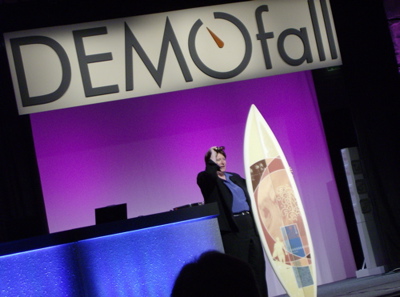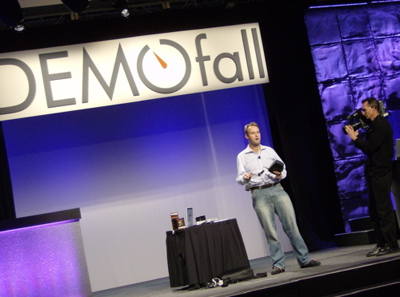The second afternoon of the two-day event was a real marathon session of non-stop demonstrations — 21 pitches in two and a half hours! (With no break!) It was focused on these themes:
• Talk Is Cheap, and Easy – new cost-saving technologies from VOIP, to smart conferencing, to new hardware
• Express Yourself – tools for consumer-generated content, the king of the online world, whether for business, learning, or personal expression
• It’s Nice to Share…Social Content – social networks meet consumer content to bring rich contexts to both relationships and information
• Tag, You’re It! – collecting, managing, organizing, referencing, and sharing the information you find online
• Finding and Delivering All That Rich Media – a presenter that taps the power of peer-to-peer networks to efficiently deliver rich media
• The Connected Desktop – online information is feeding desktop apps, and they in turn are extending to the Internet and beyond
I won’t even think of trying to describe them all — my brain still aches — but let me pick out a few that impressed me. There were some very visually stunning apps and UIs shown this afternoon. Call it the “image” session — as in how it matters on the web. Let’s start, however, with a couple of apps that are more about talk.
Jajah is pretty cool, and a real disrupter. It lets you make free global calls with regular phones — “no software downloads, no headsets, no hassles.” The company was founded in 2005 by a pair of Austrians, and now has its U.S. headquarters in Mountain View, with a European office in Luxembourg.  They’ve raised $8 million for far from Sequoia and Globespan. Today, they announced JajahMobile, which lets you make free international calls from your cell phone — no new phone needed, no new number, and no contracts. I love the way the Demo folks describe their competition: “the global telephony industry.” Yes, indeed, and it should be plenty worried.
They’ve raised $8 million for far from Sequoia and Globespan. Today, they announced JajahMobile, which lets you make free international calls from your cell phone — no new phone needed, no new number, and no contracts. I love the way the Demo folks describe their competition: “the global telephony industry.” Yes, indeed, and it should be plenty worried.
Another VOIP play is Grand Central, a unified communications service that integrates all your phones, your numbers, and your voicemail boxes. You get one number for life and, as CEO Craig Walker said, “It’s the last number you’ll ever need.”  The system, which has a very clean, attractive interface, always tells you who’s calling, and it gives you four options on how to deal with any call: accept it, send it to voicemail, listen to the voicemail, or accept and record the call. The latter is especially useful if someone’s giving you information but you can’t write it down because you’re driving, for example. Grand Central has been funded to date with $4 million from Halsey Minor’s venture firm, Minor Ventures, also in San Francisco, and it inherited the name and domain from a previous company of Minor’s that was in an unrelated business.
The system, which has a very clean, attractive interface, always tells you who’s calling, and it gives you four options on how to deal with any call: accept it, send it to voicemail, listen to the voicemail, or accept and record the call. The latter is especially useful if someone’s giving you information but you can’t write it down because you’re driving, for example. Grand Central has been funded to date with $4 million from Halsey Minor’s venture firm, Minor Ventures, also in San Francisco, and it inherited the name and domain from a previous company of Minor’s that was in an unrelated business.
How could a web site creation and hosting service be at Demo, and how could it be something I’d expect you to be interested in? Well, SiteKreator is different! It brings really attractive, professional design to small business owners, many of whom are not yet on the web — or just can’t afford to hire a designer to custom-build their own site.  And the prices for using the site builder tool and hosting services are very reasonable, starting at just $15 per month. If you ever get called on to help friends or relatives set up a web site (don’t we all?), this is where you should send ’em! As described today, SiteKreator offers the elegance and sophistication of a design studio at the price of a common site builder.
And the prices for using the site builder tool and hosting services are very reasonable, starting at just $15 per month. If you ever get called on to help friends or relatives set up a web site (don’t we all?), this is where you should send ’em! As described today, SiteKreator offers the elegance and sophistication of a design studio at the price of a common site builder.
Perhaps the biggest newsmaker of all at the DEMOfall event was Wallop, the social networking site spun out of Microsoft. In fact, if you haven’t yet heard of it, you must be living under a rock. It was all over the TV news on Tuesday morning, and in the major print media as well.  My first real look at it was in their demo today, and I must say it’s an elegant interface. Changes the game. But it should be for what they paid Frog Design to do it! (Nothing like all that Microsoft money, and Bay Partners, too.) It was completely developed in Flash. Check it out. The business model of this MySpace and Facebook competitor is interesting — no advertising! Its revenues will come strictly from taking a 30% cut of all e-commerce on the site — but that should be a very, very nice number.
My first real look at it was in their demo today, and I must say it’s an elegant interface. Changes the game. But it should be for what they paid Frog Design to do it! (Nothing like all that Microsoft money, and Bay Partners, too.) It was completely developed in Flash. Check it out. The business model of this MySpace and Facebook competitor is interesting — no advertising! Its revenues will come strictly from taking a 30% cut of all e-commerce on the site — but that should be a very, very nice number.
Not only do I not have time to frequent social networking sites, but I’m also not a target for scrapbooking — though I do know it’s a huge market in this country (approaching $3 billion annually). Another Demo presenter, Scrapblog, is combining the storytelling qualities of scrapbooks with the sharing qualities of blogs.  Each of the “scrapblogs” you create with this free service –and it’s aimed at parents, newlyweds, vacationers, etc — is a rich-media blog that’s formatted very nicely for either sharing online or printing into a high-quality photo book. The design, attractiveness, and ease-of-use of Scrapblog was very impressive.
Each of the “scrapblogs” you create with this free service –and it’s aimed at parents, newlyweds, vacationers, etc — is a rich-media blog that’s formatted very nicely for either sharing online or printing into a high-quality photo book. The design, attractiveness, and ease-of-use of Scrapblog was very impressive.
Okay, so that’s a cool way to be creative with consumer-generated content, photos in this case. But how does the social-networking generation create “personalized multimedia entertainment experiences.” That’s what iBloks wants to bring to the party — and it was one impressive presentation.  The service lets you use your photos, videos, games, music, and sound effects to create an “immersive” mix, and then share it via email or IM, and/or publish it anywhere, to any web page or blog. The company calls its “mods” creation a totally new way for people to express themselves. And they seem to be convincing, already having raised $3 million in VC from Maveron. iBloks sees a ready market, too, citing a Forrester study that says 31% of consumers now spend an hour or more a day on social networking sites. [Now I’m wondering if anyone’s measuring how much work (or homework) isn’t getting done as a result?]
The service lets you use your photos, videos, games, music, and sound effects to create an “immersive” mix, and then share it via email or IM, and/or publish it anywhere, to any web page or blog. The company calls its “mods” creation a totally new way for people to express themselves. And they seem to be convincing, already having raised $3 million in VC from Maveron. iBloks sees a ready market, too, citing a Forrester study that says 31% of consumers now spend an hour or more a day on social networking sites. [Now I’m wondering if anyone’s measuring how much work (or homework) isn’t getting done as a result?]
Another presenting firm I just have to mention is HeyLetsGo — only because I thought they were cute, and had the cutest company name in the whole pack. What do they do? Well, they claim to be the “first social network that connects people face to face.” Unique concept huh!?  What it specifically does is connect them with local events where they can meet their friends — old and new — by the hundreds, it seems. They’re only active in their home base of Boston right now, but they had a rush of 80,000 twenty-somethings sign up on their site in a short period of time recently, still in their pre-launch phase. [And, yes, they already have Series A funding from Highland Capital and General Catalyst.] Naturally, they have plans to go national. You heard it first at Demo, folks…
What it specifically does is connect them with local events where they can meet their friends — old and new — by the hundreds, it seems. They’re only active in their home base of Boston right now, but they had a rush of 80,000 twenty-somethings sign up on their site in a short period of time recently, still in their pre-launch phase. [And, yes, they already have Series A funding from Highland Capital and General Catalyst.] Naturally, they have plans to go national. You heard it first at Demo, folks…
Another content-sharing site, which appeals to a more mainstream or mature online consumer, is eSnips. CEO Yael Elish told me her site allows “everyday people to share content in one place, without having to manage so many accounts.”  It’s about sharing, publishing, and even selling your creative work — and it’s all free. eSnips puts content at the center of things, and lets it lead the way to creating new relationships. Think artists, photographers, karioki enthusiasts, anyone who wants to share his or her passion or creative pursuits. Users each get 1 gigabyte of storage for free. You just upload to folders, each of which becomes a web site — designated private, group, or public. There’s no limit, and files can be of any type. “It’s a social network focused on finding people,” the CEO said. It must be catching on, because she said eSnips already has one million registered users, and the site is now logging 3 million unique visitors per month. Geographic distribution includes about 30% U.S., and a fairly equal spread between Canada, Europe, and Asia. The Israeli based company received a seed round of funding from Gemini Israel Funds.
It’s about sharing, publishing, and even selling your creative work — and it’s all free. eSnips puts content at the center of things, and lets it lead the way to creating new relationships. Think artists, photographers, karioki enthusiasts, anyone who wants to share his or her passion or creative pursuits. Users each get 1 gigabyte of storage for free. You just upload to folders, each of which becomes a web site — designated private, group, or public. There’s no limit, and files can be of any type. “It’s a social network focused on finding people,” the CEO said. It must be catching on, because she said eSnips already has one million registered users, and the site is now logging 3 million unique visitors per month. Geographic distribution includes about 30% U.S., and a fairly equal spread between Canada, Europe, and Asia. The Israeli based company received a seed round of funding from Gemini Israel Funds.
Alex Iskold, CEO of Adaptiveblue (and quite a blogger, too, for the Read/Write Web blog), did a great job pitching his “Blueorganizer” smart Firefox extension toward the end of the afternoon. It creates a context-sensitive, personalized web experience, and is “a step closer to the smart browser of tomorrow,” Iskold said.  The firm claims that browser personalization is the next step in personal productivity online, but notes that the market is not clearly defined — overlapping with targeted advertising, for one thing. The Demo producers call Adapativeblue’s Blueorganizer “a sight for sore eyes, going beyond social bookmarking by turning your browser into a productivity tool….It’s a browser with a brain, and it’s about time.”
The firm claims that browser personalization is the next step in personal productivity online, but notes that the market is not clearly defined — overlapping with targeted advertising, for one thing. The Demo producers call Adapativeblue’s Blueorganizer “a sight for sore eyes, going beyond social bookmarking by turning your browser into a productivity tool….It’s a browser with a brain, and it’s about time.”
The final company I’ll mention was in fact the last presenter of the day, Srivats Sampath, CEO of Mercora (and a serial entrepreneur who was on the Demo stage for the fourth time). His firm was added at the last minute by Chris Shipley after one of the others had to drop out.  He was debuting MercoraM, a new service that “transforms your smartphone into a wireless, socially connected music player.” This was very cool, and we got to hear quite an array of great music to wrap up the day’s sessions, including Vanessa-Mae’s rendition of “Classical Gas,” plus some very funky West African music that had the guys on stage dancing, and some audience members joining them. There’s only one question I have for Srivats: when can I get this for my phone, and when will you support the Mac??
He was debuting MercoraM, a new service that “transforms your smartphone into a wireless, socially connected music player.” This was very cool, and we got to hear quite an array of great music to wrap up the day’s sessions, including Vanessa-Mae’s rendition of “Classical Gas,” plus some very funky West African music that had the guys on stage dancing, and some audience members joining them. There’s only one question I have for Srivats: when can I get this for my phone, and when will you support the Mac??
That’s it from the DEMOfall showfloor, folks, right here from press row. I’ll try to do a wrapup post soon with some of my final thoughts….
Tags: DEMOfall 2006, Jajah, Grand Central, SiteKreator, Wallop, Scrapblog, iBloks, HeyLetsGo, eSnips, Adaptiveblue, Mercora
 Rich Karlgaard of Forbes. [Or as Guy Kawasaki, another friend and business partner, calls him, “Brother Rich.”]
Rich Karlgaard of Forbes. [Or as Guy Kawasaki, another friend and business partner, calls him, “Brother Rich.”] One industry where this is happening is newspapers, with the stock of the New York Times, for example, at half what it was in 2002. Why is the industry in trouble? “Craig’s List is one reason,” he said, “a company with 23 employees.” He noted that McKinsey said the topple rate will triple again, and he gave some reasons why this volatility will stay with us. “The backside of Moore’s Law is the part that’s important. As performance increases, prices drop 30% a year. Suddenly, hundreds of millions more people can afford technology every year.” He also cited the example of Google bootstrapping its way early on, with the founders not taking equity investment but instead maxing out their credit cards.
One industry where this is happening is newspapers, with the stock of the New York Times, for example, at half what it was in 2002. Why is the industry in trouble? “Craig’s List is one reason,” he said, “a company with 23 employees.” He noted that McKinsey said the topple rate will triple again, and he gave some reasons why this volatility will stay with us. “The backside of Moore’s Law is the part that’s important. As performance increases, prices drop 30% a year. Suddenly, hundreds of millions more people can afford technology every year.” He also cited the example of Google bootstrapping its way early on, with the founders not taking equity investment but instead maxing out their credit cards.  Read more about that in this Reuters story. [Another Elevation partner is Roger MacNamee, who has a rock band of his own: The Flying Other Brothers. Hey, I got the t-shirt! Right from Roger a few years ago…] Just how much money is out there? Rich laid it out: “About $1.5 trillion in risk capital is sloshing around looking to cause havoc. And about a half trillion of that is in the U.S. We’ll have volatility up the kazoo — get used to it.”
Read more about that in this Reuters story. [Another Elevation partner is Roger MacNamee, who has a rock band of his own: The Flying Other Brothers. Hey, I got the t-shirt! Right from Roger a few years ago…] Just how much money is out there? Rich laid it out: “About $1.5 trillion in risk capital is sloshing around looking to cause havoc. And about a half trillion of that is in the U.S. We’ll have volatility up the kazoo — get used to it.” “It’s growing at 70% year-over-year, and will have more ad revenue than the magazine by the end of 2007.” He said that’s what got Elevation Partners interested. “In the media business, as revenues double, valuation triples.” Forbes has very definitely become a global franchise. It’s seeing most of its growth on the Internet, and most of that growth is non-U.S. “But we’ll never give up on the magazine,” he said.
“It’s growing at 70% year-over-year, and will have more ad revenue than the magazine by the end of 2007.” He said that’s what got Elevation Partners interested. “In the media business, as revenues double, valuation triples.” Forbes has very definitely become a global franchise. It’s seeing most of its growth on the Internet, and most of that growth is non-U.S. “But we’ll never give up on the magazine,” he said. I just wish theyda told me the hotel had two towers, and that if you were unlucky enough to make your reservations a bit too late, you’d get stuck in the West Tower and have to hoof it three-quarters of a mile to where the event was held, in and around the East Tower. For the prices, there has to be a better venue in the San Diego area.
I just wish theyda told me the hotel had two towers, and that if you were unlucky enough to make your reservations a bit too late, you’d get stuck in the West Tower and have to hoof it three-quarters of a mile to where the event was held, in and around the East Tower. For the prices, there has to be a better venue in the San Diego area. It was reminiscent of the pre-crash conference scene for sure — and I wondered how many of these people were experiencing this “high” for the first time. My guess would be a large percentage, because there were many, many young faces in the crowd.
It was reminiscent of the pre-crash conference scene for sure — and I wondered how many of these people were experiencing this “high” for the first time. My guess would be a large percentage, because there were many, many young faces in the crowd.  The press policy is a very democratic one, I learned: it allows only one reporter from any one media outlet, even including the WSJ, NY Times, USA Today. But let me apologize now for not covering all 67 presenting companies. Nothing against any of you that I didn’t — just not enough time. It’s flatly impossible to do, with any depth, anyway. [I did manage to blog some 37 of them, though!]
The press policy is a very democratic one, I learned: it allows only one reporter from any one media outlet, even including the WSJ, NY Times, USA Today. But let me apologize now for not covering all 67 presenting companies. Nothing against any of you that I didn’t — just not enough time. It’s flatly impossible to do, with any depth, anyway. [I did manage to blog some 37 of them, though!] Another of my shots shows the two presenters from
Another of my shots shows the two presenters from  That’s two Demo conferences in a row where companies I’ve run into early and blogged about became Demo God winners. [Just lucky, I guess…]
That’s two Demo conferences in a row where companies I’ve run into early and blogged about became Demo God winners. [Just lucky, I guess…] I was so hoping to win that nice stick (donated by sponsor Qualcomm). But, alas, the guy in front of me did — and he didn’t even seem excited about it. Dude?
I was so hoping to win that nice stick (donated by sponsor Qualcomm). But, alas, the guy in front of me did — and he didn’t even seem excited about it. Dude? But could the guy conjur up something better to wear than the most god-awful pair of jeans I’ve even seen? I look better than that when I’ve done lumberjack work for three hours in the woods behind my house, for kee-rist sakes. In his defense, he was just one of several presenters who were dressed shabbily. And, sorry, anything including jeans fits that category for me. Please, Chris, can we have a dress code for presenters? It’s the least they can do for us. Hey, if Steve Jobs is coming on stage — fine, he wears what he wants. But these guys, they ain’t no Steve Jobs — okay? 🙂 Certainly not yet… And having them pretend like they are is just too hard to stomach.
But could the guy conjur up something better to wear than the most god-awful pair of jeans I’ve even seen? I look better than that when I’ve done lumberjack work for three hours in the woods behind my house, for kee-rist sakes. In his defense, he was just one of several presenters who were dressed shabbily. And, sorry, anything including jeans fits that category for me. Please, Chris, can we have a dress code for presenters? It’s the least they can do for us. Hey, if Steve Jobs is coming on stage — fine, he wears what he wants. But these guys, they ain’t no Steve Jobs — okay? 🙂 Certainly not yet… And having them pretend like they are is just too hard to stomach. It provides an overview of the event — the tone, the tenor, the themes. Check it out
It provides an overview of the event — the tone, the tenor, the themes. Check it out  They’ve raised $8 million for far from Sequoia and Globespan. Today, they announced JajahMobile, which lets you make free international calls from your cell phone — no new phone needed, no new number, and no contracts. I love the way the Demo folks describe their competition: “the global telephony industry.” Yes, indeed, and it should be plenty worried.
They’ve raised $8 million for far from Sequoia and Globespan. Today, they announced JajahMobile, which lets you make free international calls from your cell phone — no new phone needed, no new number, and no contracts. I love the way the Demo folks describe their competition: “the global telephony industry.” Yes, indeed, and it should be plenty worried. The system, which has a very clean, attractive interface, always tells you who’s calling, and it gives you four options on how to deal with any call: accept it, send it to voicemail, listen to the voicemail, or accept and record the call. The latter is especially useful if someone’s giving you information but you can’t write it down because you’re driving, for example. Grand Central has been funded to date with $4 million from Halsey Minor’s venture firm, Minor Ventures, also in San Francisco, and it inherited the name and domain from a previous company of Minor’s that was in an unrelated business.
The system, which has a very clean, attractive interface, always tells you who’s calling, and it gives you four options on how to deal with any call: accept it, send it to voicemail, listen to the voicemail, or accept and record the call. The latter is especially useful if someone’s giving you information but you can’t write it down because you’re driving, for example. Grand Central has been funded to date with $4 million from Halsey Minor’s venture firm, Minor Ventures, also in San Francisco, and it inherited the name and domain from a previous company of Minor’s that was in an unrelated business.  And the prices for using the site builder tool and hosting services are very reasonable, starting at just $15 per month. If you ever get called on to help friends or relatives set up a web site (don’t we all?), this is where you should send ’em! As described today, SiteKreator offers the elegance and sophistication of a design studio at the price of a common site builder.
And the prices for using the site builder tool and hosting services are very reasonable, starting at just $15 per month. If you ever get called on to help friends or relatives set up a web site (don’t we all?), this is where you should send ’em! As described today, SiteKreator offers the elegance and sophistication of a design studio at the price of a common site builder. My first real look at it was in their demo today, and I must say it’s an elegant interface. Changes the game. But it should be for what they paid Frog Design to do it! (Nothing like all that Microsoft money, and Bay Partners, too.) It was completely developed in Flash. Check it out. The business model of this MySpace and Facebook competitor is interesting — no advertising! Its revenues will come strictly from taking a 30% cut of all e-commerce on the site — but that should be a very, very nice number.
My first real look at it was in their demo today, and I must say it’s an elegant interface. Changes the game. But it should be for what they paid Frog Design to do it! (Nothing like all that Microsoft money, and Bay Partners, too.) It was completely developed in Flash. Check it out. The business model of this MySpace and Facebook competitor is interesting — no advertising! Its revenues will come strictly from taking a 30% cut of all e-commerce on the site — but that should be a very, very nice number. Each of the “scrapblogs” you create with this free service –and it’s aimed at parents, newlyweds, vacationers, etc — is a rich-media blog that’s formatted very nicely for either sharing online or printing into a high-quality photo book. The design, attractiveness, and ease-of-use of Scrapblog was very impressive.
Each of the “scrapblogs” you create with this free service –and it’s aimed at parents, newlyweds, vacationers, etc — is a rich-media blog that’s formatted very nicely for either sharing online or printing into a high-quality photo book. The design, attractiveness, and ease-of-use of Scrapblog was very impressive. The service lets you use your photos, videos, games, music, and sound effects to create an “immersive” mix, and then share it via email or IM, and/or publish it anywhere, to any web page or blog. The company calls its “mods” creation a totally new way for people to express themselves. And they seem to be convincing, already having raised $3 million in VC from Maveron. iBloks sees a ready market, too, citing a Forrester study that says 31% of consumers now spend an hour or more a day on social networking sites. [Now I’m wondering if anyone’s measuring how much work (or homework) isn’t getting done as a result?]
The service lets you use your photos, videos, games, music, and sound effects to create an “immersive” mix, and then share it via email or IM, and/or publish it anywhere, to any web page or blog. The company calls its “mods” creation a totally new way for people to express themselves. And they seem to be convincing, already having raised $3 million in VC from Maveron. iBloks sees a ready market, too, citing a Forrester study that says 31% of consumers now spend an hour or more a day on social networking sites. [Now I’m wondering if anyone’s measuring how much work (or homework) isn’t getting done as a result?]  What it specifically does is connect them with local events where they can meet their friends — old and new — by the hundreds, it seems. They’re only active in their home base of Boston right now, but they had a rush of 80,000 twenty-somethings sign up on their site in a short period of time recently, still in their pre-launch phase. [And, yes, they already have Series A funding from Highland Capital and General Catalyst.] Naturally, they have plans to go national. You heard it first at Demo, folks…
What it specifically does is connect them with local events where they can meet their friends — old and new — by the hundreds, it seems. They’re only active in their home base of Boston right now, but they had a rush of 80,000 twenty-somethings sign up on their site in a short period of time recently, still in their pre-launch phase. [And, yes, they already have Series A funding from Highland Capital and General Catalyst.] Naturally, they have plans to go national. You heard it first at Demo, folks… It’s about sharing, publishing, and even selling your creative work — and it’s all free. eSnips puts content at the center of things, and lets it lead the way to creating new relationships. Think artists, photographers, karioki enthusiasts, anyone who wants to share his or her passion or creative pursuits. Users each get 1 gigabyte of storage for free. You just upload to folders, each of which becomes a web site — designated private, group, or public. There’s no limit, and files can be of any type. “It’s a social network focused on finding people,” the CEO said. It must be catching on, because she said eSnips already has one million registered users, and the site is now logging 3 million unique visitors per month. Geographic distribution includes about 30% U.S., and a fairly equal spread between Canada, Europe, and Asia. The Israeli based company received a seed round of funding from Gemini Israel Funds.
It’s about sharing, publishing, and even selling your creative work — and it’s all free. eSnips puts content at the center of things, and lets it lead the way to creating new relationships. Think artists, photographers, karioki enthusiasts, anyone who wants to share his or her passion or creative pursuits. Users each get 1 gigabyte of storage for free. You just upload to folders, each of which becomes a web site — designated private, group, or public. There’s no limit, and files can be of any type. “It’s a social network focused on finding people,” the CEO said. It must be catching on, because she said eSnips already has one million registered users, and the site is now logging 3 million unique visitors per month. Geographic distribution includes about 30% U.S., and a fairly equal spread between Canada, Europe, and Asia. The Israeli based company received a seed round of funding from Gemini Israel Funds.  The firm claims that browser personalization is the next step in personal productivity online, but notes that the market is not clearly defined — overlapping with targeted advertising, for one thing. The Demo producers call Adapativeblue’s Blueorganizer “a sight for sore eyes, going beyond social bookmarking by turning your browser into a productivity tool….It’s a browser with a brain, and it’s about time.”
The firm claims that browser personalization is the next step in personal productivity online, but notes that the market is not clearly defined — overlapping with targeted advertising, for one thing. The Demo producers call Adapativeblue’s Blueorganizer “a sight for sore eyes, going beyond social bookmarking by turning your browser into a productivity tool….It’s a browser with a brain, and it’s about time.”  He was debuting
He was debuting 
Recent Comments